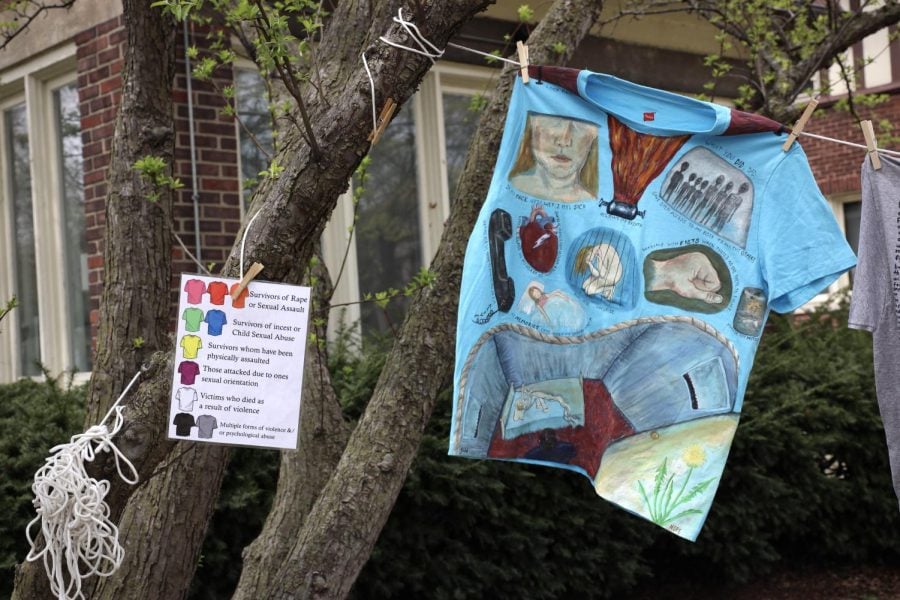The Clothesline Project affirms survivors, shares their stories to conclude Sexual Assault Awareness Month
Joanne Haner/Daily Senior Staffer
Individual shirts featured hand-drawn testimonies from survivors of sexual violence at The Clothesline Project.
May 1, 2022
Content Warning: This story contains mentions of sexual assault, domestic violence and abuse.
Colorful T-shirts with handwritten messages from survivors of sexual abuse and assault draped various parts of the Lakefill Sunday.
“Like glass in my heart, no matter which way I turn it hurts,” one of the shirts read. “What you did, Dad, gave open access to my body to all the others.”
The shirts were made by survivors at Northwestern and the rest were provided by the Northwest Center Against Sexual Assault as part of the national Clothesline Project.
NU’s Center for Awareness, Response and Education partnered with Students Promoting Education, Awareness and Knowledge for Change to host the annual Clothesline Project in commemoration of Sexual Assault Awareness Month.
“The accumulation of shirts is a graphic reminder of how pervasive violence is,” said Katelyn Kennon, assistant director of sexual violence response at CARE. “It also is an accumulation of strength and an accumulation of stories that survivors feel like they no longer have to keep to themselves.”
The Clothesline Project began in 1990 to shed light on gender-based violence through education and healing. Through the T-shirts, the founders — many of whom experienced personal violence — sought an “in your face” tactic to promote their cause, according to the project’s website.
The project has since expanded to bring awareness to other forms of sexual violence, including to survivors of child sexual abuse and sexual orientation violence. Each shirt color represents a different type of violence.
Every year, survivors and their loved ones decorate the shirts to express their feelings and share their stories.
“The shirts are then hung up to be viewed as testimony to the problem of interpersonal violence and to let those who may suffer in silence know that they are not alone,” the project’s mission statement read.
Along with the Sunday exhibition, organizers also displayed a clothesline outside the Women’s Center Friday and hosted a recharge event inside the building. Participants could drop in to receive confidential support, grab a snack or make a craft.
The theme for CARE’s Sexual Assault Awareness Month programming this year was “Archiving Our Narratives, Proliferating Our Voices.” Kennon said since storytelling is central to the theme, the Clothesline Project provided a perfect medium for survivors to share their stories and for the public to share messages of support.
Lynn Ahn, the events chair for NU’s SPEAK for Change, said her personal experiences motivated her to take part in the project. As a survivor, Ahn said she found healing through activist work.
In the aftermath of their assault, Ahn said they felt isolated after several experiences where people around them dismissed their story. They said listening to others ’stories has been an affirming and healing experience, and has validated a lot of their feelings.
“After I was assaulted, I didn’t know it was assault…I didn’t act like anything happened,” Ahn said. “When you have these stories, people realize that ‘No, this is wrong,’ (and then) you can work towards healing.”
Kennon said the Clothesline Project is just one way of centering survivors, and CARE hopes to continue the momentum it created this month with consistent programming that represents a variety of voices and perspectives.
“Our hope is that survivors can begin to share these stories publicly without shame and receive the support and care that they deserve,” Kennon said.
Ahn said she also hopes Clothesline will lead the University toward more tangibly supporting survivors. At NU, she said it’s all too common for survivors to take on the onus for the response to their assault.
It’s often up to survivors to arrange accommodations, transfer out of classes their abusers are in or advocate for themselves, they added.
“The point of all the shirts is to show that we’re not just a statistic,” Ahn said. “Even though you don’t see the people who would be wearing the shirt, it’s representative of thousands of survivors.”
Email: [email protected]
Twitter: @joannah_11
Email: [email protected]
Twitter: @yolamzi
Related Stories:
— Keynote speaker for Sexual Assault Awareness Month Chanel Miller speaks on reframing her narrative
— Northwestern washes away sexual assault survivor’s story painted around the Rock












